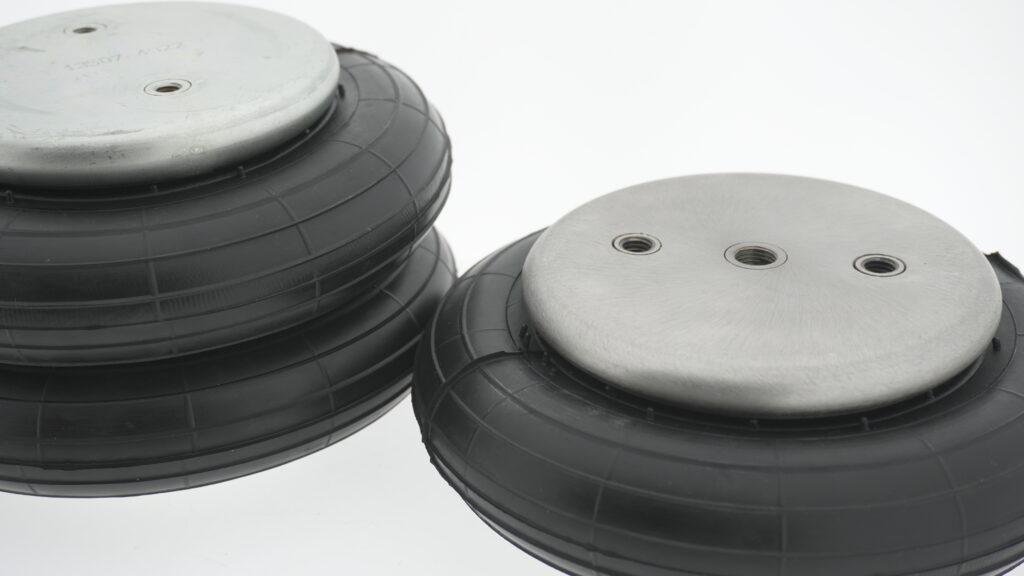
Understanding air bellows lifespan in industrial applications
Air bellows are essential in industrial applications, providing vibration isolation and controlled motion. Their lifespan depends on material quality, operating conditions, and maintenance. Understanding air bellows replacement helps maintain efficiency and avoid downtime.
Standard air bellows operate under 8 to 12 bar pressure, with materials like natural rubber (NR/SBR), nitrile (NBR), and ethylene propylene diene (EPDM). These materials endure -40°C to +115°C. Reinforced fabric layers and steel bead rings improve load distribution and structural integrity. Four-ply constructions provide higher load capacities. Correct material selection reduces failure risks. Storage in cool, dry environments extends lifespan. Preventing exposure to UV light and ozone-producing equipment ensures long-term reliability. Routine inspections and preventative maintenance further extend operational life and efficiency.
Factors affecting air bellows longevity
Material composition and construction
The durability of air bellows depends on materials used. High-quality elastomers like NR/SBR, NBR, and EPDM offer resistance to wear, temperature, and chemicals. Reinforced fabric plies and steel bead rings improve durability, ensuring load distribution.
Industrial air bellows feature dismountable bead rings, crimped closures, and reinforced mounting plates. Stainless steel AISI-304 or AISI-316L options increase corrosion resistance. Rubber compounds resist oils, fuels, and ozone, while four-ply designs handle 12 bar pressure. Proper air bellows selection prevents early wear, enhances system stability, and ensures long-term performance. Rubber hardness testing detects material degradation. Correct mounting minimizes misalignment, reducing failure risk. Choosing appropriate elastomers for specific industrial needs prevents mechanical strain.
Operating pressure and load capacity
Industrial air bellows work under 8 to 12 bar pressures. Overpressure or excessive loads accelerate wear and reduce lifespan. Regular pressure checks prevent early failure.
Single convolution bellows suit limited strokes, while double and triple convolution models provide greater stroke and force capacity. Load ratings range from 0.5 kN to 450 kN, ensuring stability. Larger models offer extended height adjustments with optimized force transmission. Correctly regulating air pressure prevents overexpansion and mechanical stress. Operators should follow manufacturer recommendations to ensure maximum efficiency. Checking air inlet conditions prevents contamination, maintaining optimal pressure retention. Ensuring even weight distribution reduces stress concentrations, avoiding localized material fatigue.
Environmental exposure and working conditions
Environmental factors significantly impact air bellows lifespan. Exposure to UV light, ozone, temperature extremes, and chemicals degrades rubber, reducing flexibility and durability. Storing air bellows in controlled conditions extends service life.
Industrial air bellows endure high dynamic loads and temperature fluctuations. Chlorobutyl (CIIR) models provide chemical resistance, while nitrile (NBR) models resist oils. Standard air bellows function within -40°C to +115°C, making them ideal for extreme conditions. Elastomer compounds shield against abrasion, aging, and atmospheric exposure. Checking for surface cracking prevents premature failures. Storing spare air bellows in low-humidity, temperature-controlled areas prevents degradation before installation. Regular exposure assessments help detect early material weaknesses, ensuring continued system integrity and reliability.
Mechanical fatigue and vibration cycles
Air bellows in high-frequency applications experience constant flexing. This repeated motion weakens material integrity, leading to micro-tears, air leaks, and failure risks.
Air bellows achieve 99% vibration isolation efficiency, reducing structural wear. Reinforced mounting interfaces ensure secure installation. Maximum axial strokes range from 20 mm to over 400 mm, ensuring stable motion while minimizing stress. Preventing shock loading improves lifespan. Fatigue-resistant elastomers extend usability in high-cycle applications. Monitoring stroke consistency ensures mechanical integrity. Checking for torsional loads prevents misalignment issues. Operators should use load tracking systems to monitor mechanical strain. Ensuring correct pressure adjustment prevents excessive force, reducing premature fatigue-related failures.
Signs indicating the need for replacement
Timely air bellows replacement prevents costly failures. Signs indicating replacement needs include:
- Cracks or surface degradation affecting material flexibility.
- Loss of pressure retention, indicating leaks or structural weaknesses.
- Reduced stroke efficiency decreasing system performance.
- Altered natural frequency, compromising vibration isolation.
- Visible deformation or bulging, exceeding standard operating conditions.
Routine inspections ensure early failure detection. Conducting material hardness tests reveals rubber aging. Compression testing maintains stroke retention. Implementing predictive monitoring minimizes downtime. Checking mounting threads, bead rings, and metal plate integrity reduces stress failures. Using high-quality elastomers extends replacement intervals. Scheduling annual performance assessments improves maintenance efficiency. Operators should establish inspection logs to track degradation patterns. Implementing load cycle recording systems helps optimize replacement timing.
Recommended replacement intervals for industrial air bellows
Replacement frequency depends on operating conditions. General recommendations include:
- Standard air bellows: Replace every 3 to 5 years.
- High-frequency applications: Inspect annually, replace every 2 to 3 years.
- Extreme environments: Replace within 2 years if exposed to ozone, chemicals, or extreme temperatures.
- Heavy load usage: Inspect regularly, replace every 2 to 4 years.
High-frequency systems require enhanced monitoring. Tracking load cycles improves replacement accuracy. Predictive maintenance tools enhance scheduling efficiency. Monitoring elastic fatigue trends minimizes sudden failures. Operators should review air bellows stroke variations periodically. Heat-exposed bellows degrade faster, requiring earlier inspections. Inspecting air inlet connections prevents internal contamination. Establishing a structured inspection plan ensures prolonged operational reliability. Utilizing temperature-resistant elastomers extends usability in harsh conditions.
Final thoughts on optimizing air bellows replacement
Using a proactive replacement strategy improves system performance, safety, and cost-efficiency. Understanding lifespan factors, monitoring wear signs, and performing scheduled maintenance extends air bellows service life.
Optimizing pressure control, material choice, and installation maximizes durability. Proper alignment minimizes strain, ensuring stroke efficiency. Investing in reinforced air bellows with high-quality elastomers and corrosion-resistant components improves long-term performance. Routine wear analysis prevents unexpected breakdowns. Operators should integrate replacement forecasting methods to plan replacements efficiently. Extending maintenance cycles reduces operational disruptions. Using chemical-resistant coatings further enhances resilience in industrial environments. Correct pressure settings reduce stress on internal components. Testing air retention levels verifies performance consistency. Tracking load distribution changes prevents excessive wear.
